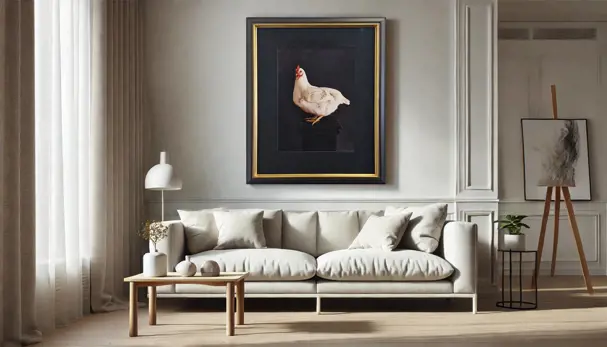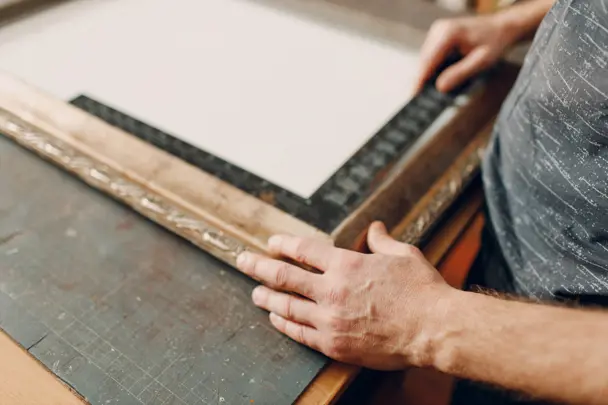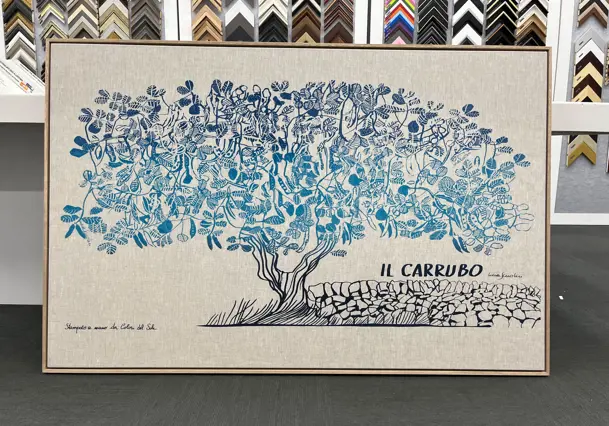Everything you need to know about custom framing
When it comes to picture framing the process can be quite daunting. Before you can even consider the actual framing of your favorite artwork, photo or memorabilia item you first need to choose a framer you can trust. Once you've done that, you have a plethora of options of frames, mat boards and even glass (that's right... not all glass is made equal).
So let's take a quick look at the core components of any picture framing job, so you better understand what you need to decide on:
Frame
This is usually the hardest part in custom framing. With so many options available there are 3 important aspects to consider:
- What complements the artwork, photograph or object Some frames can completely clash with the subject that's being framed. All good framing stores have corner samples of all the frames which aid in visualising the finished product. These corner samples allow us to sit the frame up against the artwork or photograph to see how well it complements the piece. A lot of frame samples will look great on the sample board but once placed near the piece to be framed, you will notice the colour or finish can appear to change when next to other colours or textures.
- Where is it going to be hung Considering the surrounds where your picture frame is going to hang is also important. Although there are no hard and fast rules, there are some key considerations you should be aware of. Imagine framing a classical Vincent Van Gogh print in a beautiful ornate gold frame and hanging it in a modern minimalist home - not a great look! If you are framing something as a gift, apply the KISS rule (Keep It Simple Stupid) because there’s a good chance the style and colour you choose may not match the recipients home or room where they would like to hang their gift.
- Your personal preference Of course this is important, after all you have to live with it and want to love it for years to come. It’s your hard-earned money that you are investing so you want to ensure you are 100% happy with the choices you make including environmentally conscious frame choices. However, you should keep in mind that, as professional framers, we do this for a living and can offer you some great advice and avoid frame selection mistakes that can be easily made without expert advice.
Learn about choosing the right frame size here.
Mat Boards
A mat board (or mount) is what appears to be a coloured cardboard border that surrounds your image. I say "appears to be" because it's more complicated than just choosing colour. Since a matboard is not compulsory, first you need to consider if you want one for visual appearance or need one for it's protective properties. If you do add a mat board, you might want to also consider double, triple or more matting or add highlights such as v-grooves, multi-openings and even custom cut openings. Our computerised mat cutter can cut almost any 2-D shape such as stars, objects and names (a popular addition to personal memorabilia).
At Frame Today we only use acid and lignin free matboards because they are designed to stand the test of time, resisting the effects of acid degradation and resisting fading so they keep their intended colour.
When guiding your matboard selection, we offer 3 main choices:
- Standard mats are a fantastic choice for most prints, posters and photographs. They are treated paper based pulp, that are neutralised to make them acid and lignin free to protect your artwork. These mats come in a large range of colours and are a great value option.
- Conservation mats are the next step up and have been chemically treated to remove any imperfections that may impede the longevity of your mat and artwork. These are marinally more expensive and come in a wider range of colours. Due to the choice of colours and superior quality these are great value and the most popular choice when framing items of personal value.
- Museum mats are 100% cotton so they are naturally acid free and adhere to the Fine Art Trade Guild and Professional Picture Framers Association standards. These are the premium option matboard and highly recommended when framing valuable or irreplaceable items that need to be preserved in their original condition.
Learn more about mat boards here.
Backing board
Selecting the backing board is the easiest component to select and your framer will advise which option is best. Because it sits behind the artwork or item it is out-of-sight and purely functional, but still an important framing component. Most professional framers will use one of 2 options:
- Non-adhesive foam core board on which your items is floated on top of (not stuck to). This is light weight and holds your item in place in the frame. At Frame Today we only use acid-free foamcore because it protects your artwork or item at a very cost effective price.
- Adhesive foam core board, as it's name suggests, is foamcore with an adhesive layer on which your photo, print or poster is stuck. It's most commonly used for non-valuable items because it's permanent - once mounted and pressed in our roller, it isn't coming off. Id your poster, print or photo is wavy, sticking it down will result in a perfectly flat finish. Remember, sticking anything down is usually permanent and is not advised for valuable or irreplaceable pieces.
Some smaller framers or bulk wholesale framers offer other backing options such as core flute, MDF (compressed wooden particle board) or even cardboard but in our opinion, all of these options should be avoided. Core flute and cardboard offer no protective qualities. Coreflute, due to it's construction, is naturally wavy so you can't get a flat finish. Cardboard will swell with the smallest amount of humidity, as can MDF. And MDF, a popular choice in cheap frames, is heavy to hang which makes hanging your picture frames harder than it should be.
Glass
Finally, we have the picture frame glass or glazing. There are a few options here to consider which we covered in our article Glass is not all it appears to be. Here's an overview:
- Clear Float Glass is the standard glass option and is very cost effective. It is highly reflective but if not in a high lit area can be fantastic and provide protection from dust, bugs and fingerprints.
- Non-Reflective or Non Glare Glass has a special non reflective coating that diffuses light and eliminates reflection caused by light reflecting on the glass surface. Because of this coasting it must be close to the image. As the space between artwork and glass gets wider, you start to see a haziness in the glass. Non glare glass can, in some cases, slightly dull our brighten colours in the artwork.
- UV Glass is a conservation framing option that cuts down ultra violet light that can cause fading of your framed item. UV glass is available in clear and non-glare. Both options provide 99% UV protection that prevents fading of items such as photos, signatures, art prints, jerseys and other framed objects.
- Museum Glass is the highest grade picture framing glass. It provides 99% UV protection, and provides reflection free viewing and amazing clarity with enhanced colours, brightness and contrast. It's perfect for personally valuable items that are irreplaceable and financially valuable works.
So that’s it. You’re now ready to visit your nearest framing store, armed with the essential information so you can make an informed choice when investing in your next frame... all with the guidance of your professional framer of course.



